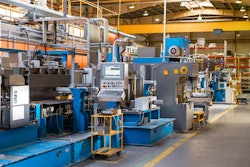
Over the last year, the manufacturing industry has faced significant disruption. Inflation and recession fears, continued economic instability and a tight labor market, not to mention global conflict and political instability, have all left manufacturers with no shortage of challenges to overcome. As in any new year, the manufacturing industry will largely look to technology to meet these challenges.
Here are some of the top technology trends expected in the manufacturing industry in 2023 and beyond:
1. Manufacturers will ramp up digital initiatives to attract the next generation of workers
As more and more veteran workers retire, manufacturers must ramp up their digital initiatives to attract the next crop of workers who grew up in a digital world, with always-on connectivity and data at their fingertips. However, a reliance on legacy paper-based processes and spreadsheets risks pushing the next generation of talent to more digitally advanced industries. Manufacturers will increasingly look to digitize manual processes that are foreign to the younger generation to meet the labor gap created by older workers aging out of the labor force.
Recent research found that 95% of discrete manufacturers still use paper-based processes (27% still use paper for more than half of all processes). It is imperative that manufacturers embrace technology on the shop floor to attract new labor.
2. Cloud adoption will unlock expanded access to analytics, driving a revolution in smarter decision support by manufacturers
2023 will be the year discrete manufacturers start to unleash the full power of analytics. To date, some have been using analytics for quality inspection and security use cases, but it will increasingly be used across key areas of operations, such as overall production performance, customer experience, product traceability and safety programs.
Recent research revealed a growing shift to cloud-based manufacturing execution software (MES) as manufacturers migrate key operations and analytics applications to take full advantage of the benefits of a hosted cloud infrastructure. For the analytics revolution to truly take off, however, more will need to jump to the cloud.
3. Increased cloud adoption means increased security risks
Manufacturers, particularly small to medium-sized enterprises (SMEs), are increasingly embracing migrating their operations to the cloud. At the same time, attacks targeting cloud infrastructure are on the rise, according to the Netwrix 2022 Cloud Data Security Report, and the industry most vulnerable to attacks on the cloud is manufacturing. Slightly more than half of manufacturing companies experienced an attack on their cloud infrastructure in the past year, according to the report.
Focusing on cybersecurity represents a significant change for manufacturing leaders, many of whom still think in terms of physical risks-they're not yet used to the idea of advanced persistent threats targeting a manufacturer.
Manufacturing operations are no longer just physical plants. They are cloud computing infrastructures, subject to the same cyber threats that target every other business. Because of this, manufacturers' approach to cybersecurity needs to reflect that. Cybersecurity can no longer just be an IT consideration. It's a critical business decision that can potentially make or break an organization and all of its operations.
4. Inflation will drive manufacturers to focus on visibility for better forecasting
Current economic uncertainty and the threat of a looming recession will force manufacturers to take a closer look at their operations, and how they collect and use data. Expect a sustained focus on putting systems in place to drive better visibility and improved forecasting as an essential part of managing day-to-day manufacturing operations and generating informed production and inventory forecasts.
Without proper visibility into the shop floor, businesses have blind spots and struggle to improve performance. A new generation of AI-powered machine learning is redefining what “visibility” means to executives, empowering organizations to better navigate volatile markets while outperforming their competitors in cost and speed.















![Pros To Know 2026 [color]](https://img.sdcexec.com/mindful/acbm/workspaces/default/uploads/2025/08/prostoknow-2026-color.mduFvhpgMk.png?ar=16%3A9&auto=format%2Ccompress&bg=fff&fill-color=fff&fit=fill&h=135&q=70&w=240)

